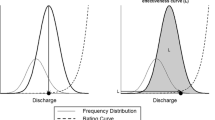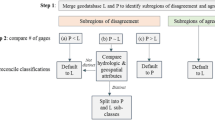Abstract
Water temperature is a key driver of aquatic processes. Monitoring stream water temperature is key to understanding current species distributions and future climate change impacts on freshwater ecosystems. However, a very small fraction of streams are continuously monitored for water temperature throughout North America, due to prohibitive logistical costs. We develop a framework that aids in developing cost-effective stream temperature monitoring by using stream habitat features to inform strategic site selection of temperature monitoring sites. We test this framework using sockeye salmon spawning streams as a model, which included 19 streams in the northern-most watershed of the Fraser River Basin, British Columbia, Canada. The objective of this framework is to evaluate the trade-off between cost (i.e., the number of streams monitored) and the effectiveness of monitoring scenarios at meeting different monitoring objectives. We compared monitoring scenarios that were informed by well-established relationships between variables and that are commonly collected or available as part of other monitoring activities (stream length, magnitude, order, gradient, wetted width, and spot temperatures) and water temperature metrics (maximum, mean, and variance during August) derived from continuously monitored streams to monitoring scenarios where streams were randomly selected. Informed scenarios included streams that were selected in order of watershed level and stream habitat characteristics (e.g., longest to shortest); ordering was based on the relationship between each habitat variable and temperature metrics. Informed monitoring scenarios were then compared to random selection of monitoring sites with regard to how well monitoring scenarios met two management objectives during the critical salmon spawning period: (1) identifying streams that exceed a temperature threshold and (2) identifying streams that represent the temperature regime of a complex of streams (e.g., mean and variance of streams within an aggregate of streams). Management objectives were met by monitoring fewer streams using the informed monitoring scenarios rather than the average of the random scenarios. This highlights how common inexpensive watershed level variables that relate to stream temperature can inform the strategic selection of sites and lead to more cost-effective stream temperature monitoring.







Similar content being viewed by others
References
Allen DM, Whitfield PH, Werner A (2010) Groundwater level responses in temperate mountainous terrain: regime classification, and linkages to climate and streamflow. Hydrol Process 24:3392–3412. doi:10.1002/hyp.7757
Becker CD, Genoway RG (1979) Evaluation of the critical thermal maximum for determining thermal tolerance of freshwater fish. Environ Biol Fish 4:245–256. doi:10.1007/BF00005481
Beer NW, Anderson JJ (2013) Sensitivity of salmonid freshwater life history in western US streams to future climate conditions. Glob Change Biol 19:2547–2556. doi:10.1111/gcb.12242
Bradford MJ, Lovy J, Patterson DA (2010) Infection of gill and kidney of fraser river sockeye salmon, Oncorhynchus nerka (Walbaum), by Parvicapsula minibicornis and its effect on host physiology. J Fish Dis 33:769–779. doi:10.1111/j.1365-2761.2010.01178.x
Braun DC, Reynolds JD (2011) Relationships between habitat characteristics and breeding population densities in sockeye salmon. Can J Fish Aquat Sci 68:1–10
Braun DC, Reynolds JD (2012) Cost-effective variable selection in habitat surveys. Methods Ecol Evol 3:388–396. doi:10.1111/j.2041-210X.2011.00154.x
Braun DC, Patterson DA, Reynolds JD (2013) Maternal and environmental influences on egg size and juvenile life-history traits in Pacific salmon. Ecol Evol 3:1727–1740. doi:10.1002/ece3.555
Breau C, Caissie D (2013) Adaptive management strategies to protect Atlantic salmon (Salmo salar) under environmentally stressful conditions. DFO Canadian Science Advisory Secretariat Document 2012/164. ii+14p
Bridge JS (2003) Rivers and floodplains: forms, processes, and sedimentary record. Blackwell, Malden, pp 491
Caissie D (2006) The thermal regime of rivers: a review. Freshw Biol 51:1389–1406. doi:10.1111/j.1365-2427.2006.01597.x
Canada FAO (2005) Canada’s policy for conservation of Wild Pacific salmon 1–49
Clarke A, Johnston NM (1999) Scaling of metabolic rate with body mass and temperature in teleost fish. J Anim Ecol 68:893–905. doi:10.1046/j.1365-2656.1999.00337.x
Crozier LG, Zabel RW, Hamlet AF (2008) Predicting differential effects of climate change at the population level with life-cycle models of spring Chinook salmon. Glob Change Biol 14:236–249
Eaton JG, Scheller RM (1996) Effects of climate warming on fish thermal habitat in streams of the United States. Limnol Oceanogr 41:1109–1115
Elliott JM (1991) Tolerance and resistance to thermal stress in juvenile Atlantic salmon, Salmo salar. Freshw Biol 25:61–70
Fleming IA, Gross MR (1990) Latitudinal clines: a trade-off between egg number and size in Pacific salmon. Ecology 71:1–11
Good TP, Beechie TJ, McElhany P et al (2007) Recovery planning for endangered species act-listed Pacific salmon: using science to inform goals and strategies. Fisheries 32:426–440. doi:10.1577/1548-8446(2007)32[426:RPFESL]2.0.CO;2
Hague MJ, Ferrari MR, Miller JR et al (2011) Modelling the future hydroclimatology of the lower Fraser River and its impacts on the spawning migration survival of sockeye salmon. Glob Change Biol 17:87–98. doi:10.1111/j.1365-2486.2010.02225.x
Hague MJ, Patterson DA (2014) Evaluation of statistical river temperature forecast models for fisheries management. N Am J Fish Manag 34:132–146. doi:10.1080/02755947.2013.847879
Hrachowitz M, Soulsby C, Imholt C et al (2010) Thermal regimes in a large upland salmon river: a simple model to identify the influence of landscape controls and climate change on maximum temperatures. Hydrol Process 24:3374–3391. doi:10.1002/hyp.7756
Isaak DJ, Wollrab S, Horan D, Chandler G (2011) Climate change effects on stream and river temperatures across the northwest US from 1980–2009 and implications for salmonid fishes. Clim Change 113:499–524. doi:10.1007/s10584-011-0326-z
Kovach RP, Gharrett AJ, Tallmon DA (2012) Genetic change for earlier migration timing in a pink salmon population. Proc R Soc B Biol Sci 279:3870–3878. doi:10.1098/rspb.2012.1158
Lee CG, Farrell AP, Lotto A et al (2003) The effect of temperature on swimming performance and oxygen consumption in adult sockeye (Oncorhynchus nerka) and coho (O. kisutch) salmon stocks. J Exp Biol 206:3239–3251. doi:10.1242/jeb.00547
Lisi PJ, Schindler DE, Bentley KT, Pess GR (2013) Association between geomorphic attributes of watersheds, water temperature, and salmon spawn timing in Alaskan streams. Geomorphology 185:78–86. doi:10.1016/j.geomorph.2012.12.013
Luce C, Staab B, Kramer M et al (2014) Sensitivity of summer stream temperatures to climate variability in the Pacific Northwest. Water Resour Res 50:3428–3443. doi:10.1002/2013WR014329
Macdonald JS, Patterson DA, Hague MJ, Guthrie IC (2010) Modeling the influence of environmental factors on spawning migration mortality for sockeye salmon fisheries management in the Fraser river, British Columbia. Trans Am Fish Soc 139:768–782. doi:10.1577/T08-223.1
Magnuson JJ (1991) Fish and fisheries ecology. Ecol Appl 1:13–26
Martins EG, Hinch SG, Patterson DA et al (2011) Effects of river temperature and climate warming on stock-specific survival of adult migrating Fraser River sockeye salmon (Oncorhynchus nerka). Glob Change Biol 17:99–114. doi:10.1111/j.1365-2486.2010.02241.x
Martins EG, Hinch SG, Cooke SJ, Patterson DA (2012) Climate effects on growth, phenology, and survival of sockeye salmon (Oncorhynchus nerka): a synthesis of the current state of knowledge and future research directions. Rev Fish Biol Fish 22:887–914. doi:10.1007/s11160-012-9271-9
Mayer TD (2012) Controls of summer stream temperature in the Pacific Northwest. J Hydrol 475:323–335. doi:10.1016/j.jhydrol.2012.10.012
Mcmahon TE, Zale AV, Barrows FT et al (2007) Temperature and competition between bull trout and brook trout: a test of the elevation refuge hypothesis. Trans Am Fish Soc 136:1313–1326. doi:10.1577/T06-217.1
Moore RD (2006) Stream temperature patterns in British Columbia, Canada, based on routine spot measurements. Can Water Resour J 31:41–56
Moore JW, Beakes MP, Nesbitt HK et al (2015) Emergent stability in a large, free-flowing watershed. Ecology 96:340–347
Morrison J, Quick MCFM (2002) Climate change in the fraser river watershed: flow and termperature projections. J Hydrol 263:230–244
Nelitz MA, MacIsaac EA, Peterman RM (2007) A science-based approach for identifying temperature-sensitive streams for rainbow trout. North Am J Fish Manag 27:405–424. doi:10.1577/M05-146.1
Peterson EE, Ver Hoef JM, Isaak DJ et al (2013) Modelling dendritic ecological networks in space: an integrated network perspective. Ecol Lett 16:707–719. doi:10.1111/ele.12084
Platts WS (1979) Relationships among stream order, fish populations, and aquatic geomorphology in an Idaho river drainage. Fisheries 4:5–9. doi:10.1577/1548-8446(1979)004<0005:RASOFP>2.0.CO;2
Poole GC, Berman CH (2001) An ecological perspective on in-stream temperature: natural heat dynamics and mechanisms of human-caused thermal degradation. Environ Manage 27:787–802. doi:10.1007/s002670010188
Reed TET, Schindler DED, Hague MJM et al (2011) Time to evolve? Potential evolutionary responses of Fraser River sockeye salmon to climate change and effects on persistence. PLoS One 6:e20380. doi:10.1371/journal.pone.0020380
Reynoldson TB, Logan C, Pascoe T, Thompson SP (2006) Invertebrate biomonitoring field and laboratory manual for running water habitats. Environment Canada, National Waters Research Institute, Canadian Aquatic Biomonitoring Network
Richter A, Kolmes SA (2005) Maximum temperature limits for Chinook, coho, and chum salmon, and steelhead trout in the Pacific Northwest. Rev Fish Sci 13:23–49. doi:10.1080/10641260590885861
Schubert ND, Fanos BP (1997) Estimation of the 1994 late run sockeye salmon (Oncorhynchus nerka) escapement to the Stuart River System. Can Manusc Rep Fish Aquat Sci 1–66
Selong JH, McMahon TE, Zale AV, Barrows FT (2001) Effect of temperature on growth and survival of bull trout, with application of an improved method for determining thermal tolerance in fishes. Trans Am Fish Soc 130:1026–1037. doi:10.1577/1548-8659(2001)130<1026:EOTOGA>2.0.CO;2
Som NA, Monestiez P, Ver Hoef JM et al (2014) Spatial sampling on streams: principles for inference on aquatic networks. Environmetrics 25:306–323. doi:10.1002/env.2284
Stalberg HC, Lauzier RB, MacIsaac EA et al (2009) Canada’s policy for conservation of wild Pacific salmon: stream, lake and estuarine habitat indicators. Can Manuscr Rep Fish Aquat Sci 2859:xiii–135
Strahler AN (1957) Quantitative analysis of watershed geomorphology. Eos Trans Am Geophys Union 38:913–920
Ward JV (1985) Thermal characteristics of running waters. Hydrobiologia 125:31–46
Ward JV, Stanford JA (1982) Thermal responses in the evolutionary ecology of aquatic insects. Annu Rev Entomol 27:97–117. doi:10.1146/annurev.en.27.010182.000525
Whitfield PH (2012) Why the provenance of data matters: assessing “fitness for purpose” for environmental data. Can Water Resour J 37:23–36. doi:10.4296/cwrj3701866
Whitney CK, Hinch SG, Patterson DA (2013) Provenance matters: thermal reaction norms for embryo survival among sockeye salmon Oncorhynchus nerka populations. J Fish Biol 82:1159–1176. doi:10.1111/jfb.12055
Acknowledgments
We thank our major funders, Aquatic Climate Change Adaptation Services Program, Environmental Watch Program (Fisheries and Oceans Canada), the Fraser Watershed Program administered by the Pacific Foundation, as well as the Natural Sciences and Engineering Research Council of Canada, the Watershed Watch Salmon Society, the Climate Change Impacts Research Consortium, and the Northern Scientific Training Program for financial support. We also appreciate support for the Tom Buell endowment fund from private donors, the Pacific Salmon Foundation, Southern Endowment Fund, and the British Columbia Leading Edge Endowment Fund. We thank Tereza Zagar for measuring watershed metrics from online sources. We appreciate help from DFO staff, including Herb Herunter, Erland MacIsaac, Tracy Cone, Keri Benner, Dennis Klassen, Garry Zwack. We appreciate field support from Jan Verspoor and Rudi Verspoor and Michael Beakes. We also thank Eduardo Martins for helpful comments on this study.
Author information
Authors and Affiliations
Corresponding author
Additional information
Handling Editor: Michael T. Monaghan.
Rights and permissions
About this article
Cite this article
Braun, D.C., Reynolds, J.D. & Patterson, D.A. Using watershed characteristics to inform cost-effective stream temperature monitoring. Aquat Ecol 49, 373–388 (2015). https://doi.org/10.1007/s10452-015-9531-6
Received:
Accepted:
Published:
Issue Date:
DOI: https://doi.org/10.1007/s10452-015-9531-6




